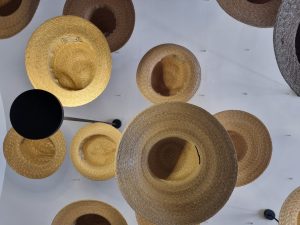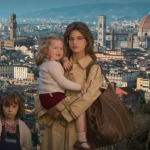When I started working as a tour leader in 2011, my first tour was in Tuscany.
I had just returned from a study trip in St. Petersburg, the ice had just thawed in a timid hint of spring on the Mojka canal, when in May I suddenly found myself immersed in the green hills of Siena.
<<Have you been to Florence? Do you know Siena and San Gimignano, right?>>
<<Of course!>> I exclaimed with enthusiasm, mockingly to the tour operator I had been targeting for years. (Anything to work for him!).
I rushed to the bookshop in Milan and stocked up on guidebooks on Tuscany. I had never been to Siena and San Gimignano, while I had been to Florence, but it’s one thing to go there alone on holiday at fifteen, and quite another one to go there with fifty French tourists who expect you to know everything.
Well, spring in Tuscany was very different from St. Petersburg, even though I loved St. Petersburg despite the frozen temperature (you never forget first loves).
The air smelled of flying butterflies, and I fell in love with Florence and the Tuscan countryside. I didn’t realize it, but the leather gloves, the marbled paper, the leather bags, the straw hats and the amazing paintings of the poppy-framed dome displayed in Piazza Pitti spoke to me of a romantic memory I had in my heart since childhood .
That of a carefree, young woman, dressed in white, in the sun, with a straw hat on her head and a poppy pinned on the black ribbon, the cicadas as a song.
The sunflowers in the background, the ever-present cypresses with their dark green, splendid and reassuring garb. Tuscany is a postcard that we all have in our hearts, even if we have never been there. Small chapels perched on the green slopes, the ringing of bells, blurred by blue (reminiscent of Pascoli poems). We are slaves to today’s life, but the land of Tuscany gives us back the freedom of the past, the sunny Sundays, the warmth of home, the high sky over backdrops painted with mastery in the Quattrocento.
This is what there is, for me, behind a straw hat.
There is a whole dream, an archetype, a timeline bordered by cypresses, which winds through the hills stained with red poppies. A straw hat is a flight of fancy.
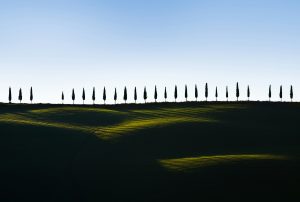
A little history of the Florentine straw hat
The art of basket making and straw making has its roots in distant times, but it was in the sixteenth century, in Tuscany, that the workmanship reached such a high level of refinement, so much so that it brought the Grand Duke Cosimo I de’ Medici (1519-1574 ) to offer gifts of straw hats to his aristocratic guests.
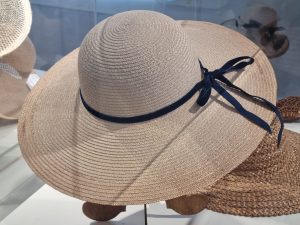 In the eighteenth century, the straw hat, known as leghorn, was in great demand by foreign customers: it was put on board ships along the Canale dei Navicelli and set sail from the port of Livorno towards foreign countries.
In the eighteenth century, the straw hat, known as leghorn, was in great demand by foreign customers: it was put on board ships along the Canale dei Navicelli and set sail from the port of Livorno towards foreign countries.
Much land near Signa, in the outskirts of Florence, was deforested expressly for the cultivation of straw for hats.
The Florence-Pisa-Livorno railway line was inaugurated by Grand Duke Leopold II Habsburg-Lorraine in 1844 and considerably favored the marketing of the straw hat.
The straw hat economy of Florence entered into crisis in 1885 with Chinese competition and again after the Second World War: in Signa, near Florence, everyone was employed in the production of hats. Supply exceeded demand. Furthermore, other production centers, such as Fermo in the Marche and Marostica in the Veneto, competed with Florence, but the strongest rival remained China.
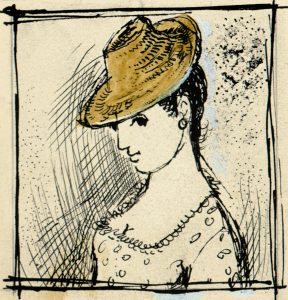 Nonetheless, the memory of the straw hat remained well imprinted in European society, as recalled by Nino Rota‘s (1911-1979) operetta “The Straw Hat of Florence”, staged for the first time in Palermo on 21 April 1955, with great success. The plot is simple and hilarious: one day, in Paris, a horse eats the straw hat of an attractive lady. The owner of the horse, Fadinard, with a certain embarrassment, sets off on a frantic search for a Florentine straw hat identical to the one swallowed by the horse, and searches all the boutiques in Paris, to repair the wrong suffered by the beautiful madame. Will there be a happy ending? Mais oui!
Nonetheless, the memory of the straw hat remained well imprinted in European society, as recalled by Nino Rota‘s (1911-1979) operetta “The Straw Hat of Florence”, staged for the first time in Palermo on 21 April 1955, with great success. The plot is simple and hilarious: one day, in Paris, a horse eats the straw hat of an attractive lady. The owner of the horse, Fadinard, with a certain embarrassment, sets off on a frantic search for a Florentine straw hat identical to the one swallowed by the horse, and searches all the boutiques in Paris, to repair the wrong suffered by the beautiful madame. Will there be a happy ending? Mais oui!
In 1986, the Consortium “Il Cappello di Firenze” was established within the Association of Industrialists of the Province of Florence. The Consortium brings together the main companies in the sector, heirs of the ancient straw processing which had its maximum expression in the Signa area.
Domenico Michelacci and the straw manufacturing process
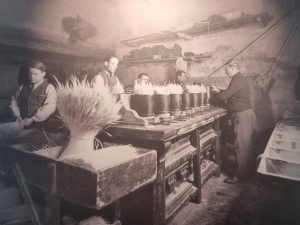
In 1714, Domenico di Sebastiano Michelacci arrived in Signa from Gallata, in the province of Forlì. After several experiments, in 1718 he selected marzuolo wheat, also known as gentil rosso (Triticum aestivum), known since the age of the ancient Romans, for the hats production.
Sowing took place by placing the grains very close to each other, at a shallow depth, so that the plant grew thin and long. Before the wheat reached maturity, the plant was torn from the ground with the entire root, so that the sap remained inside the stem and made it more flexible.
After harvesting, the manufacturing process involved several phases: soleggiatura (sun exposure), sfilatura (extraction), and selezione (selection).
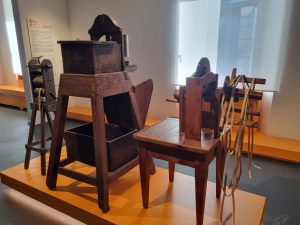 Left to dry for three days in the sun, the golden straw was collected while still moist with the morning guazza (guazza is the Tuscan word for dew). Once the water had evaporated, the selected straw was ready for the macchina agguagliatrice (cutting machine). The bundles of straw, called manate, were bought by the delivery boys who distributed them to the women for processing.
Left to dry for three days in the sun, the golden straw was collected while still moist with the morning guazza (guazza is the Tuscan word for dew). Once the water had evaporated, the selected straw was ready for the macchina agguagliatrice (cutting machine). The bundles of straw, called manate, were bought by the delivery boys who distributed them to the women for processing.
The first factory for the production of straw hats was founded in Signa in 1735.
Florentine women at work: trecciaiole, bigherinaie and the first strike
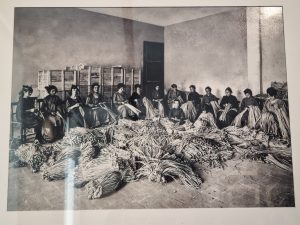
The straw hat was a godsend for the women of the Florentine area: weaving straw was a job that could be done at home and was paid. This allowed women to earn, pay the rent, contribute to the family economy without leaving home and in some cases, to provide their dowry themselves.
The trecciaiole (from treccia: braid) profession was run at home until the nineteenth century, when their work moved to the factories.
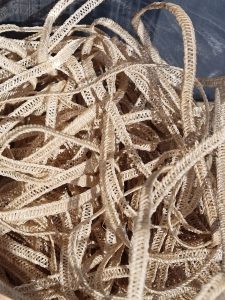
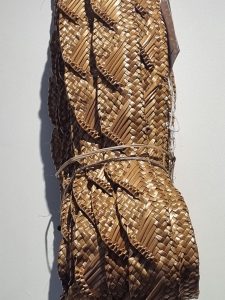
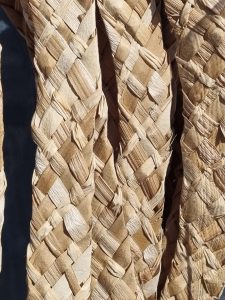
The trecce (braids) worked by the trecciaiole could be a stuoia (wicker-one) or a fantasia (patterned-one). The stuoia (wicker-one) was traditionally used for the straw hat of Florence. It had a smooth and regular pattern. The fantasia (patterned-one), however, included at least a hundred variations, often inspired by embroidery and fabrics. The processing was manual until the end of the nineteenth century, when sewing machines were introduced to complete the hats, which were modeled on a wooden form, to which the sewn cone was adhered with a special iron.
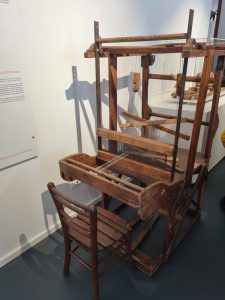 In the first half of the 19th century, the bigherinaie worked in Fiesole. These women did not work the braid like the trecciaiole did in Signa, but the “bigherini“, a sort of passemanterie, invented in Wohlen, Switzerland. The bigherini combined straw with silk, cotton, horsehair and other materials; unlike braiding, they were worked on a loom. Like the trecciaiole, the bigherinaie also initially worked at home, then entered the factory at the end of the nineteenth century. The industry was very flourishing in Fiesole until the twentieth century and allowed the bigherinaie to have a certain economic independence.
In the first half of the 19th century, the bigherinaie worked in Fiesole. These women did not work the braid like the trecciaiole did in Signa, but the “bigherini“, a sort of passemanterie, invented in Wohlen, Switzerland. The bigherini combined straw with silk, cotton, horsehair and other materials; unlike braiding, they were worked on a loom. Like the trecciaiole, the bigherinaie also initially worked at home, then entered the factory at the end of the nineteenth century. The industry was very flourishing in Fiesole until the twentieth century and allowed the bigherinaie to have a certain economic independence.
Due to Chinese competition that offered products at lower prices, women suffered a reduction in wages (the pay went from approximately 2-8 lire a day to 50 cents a day).
On 15th May 1896, the trecciaiole organized the first strike in their history. The gesture of the trecciaiola Barsene Conti is very famous, as she lay down in protest on the tram tracks, loaded with straw hats. Even the tobacconists of Florence and the fiascaries of Empoli joined the protest. Barsene Conti served a year in prison. The women’s protests lasted for months, but unfortunately wages were not increased.
Tailor-made guided tours at the Straw Museum in Signa
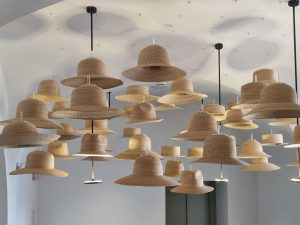
The Straw Museum was opened in 1997 in Signa, a few kilometers from Florence. The new exhibition venue, inaugurated in 2023, collects a splendid series of hats, artefacts, clothes and work machinery, which tell and enhance the local and authentic history of the area, focusing on the figure of Domenico Michelacci and the key role of the trecciaiole . The Museum also houses the Manufacturing Room, where terracotta works produced in Signa are exhibited.
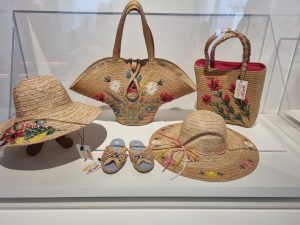
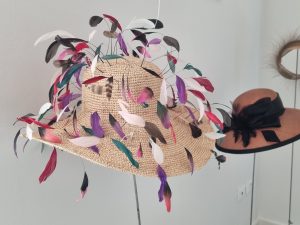
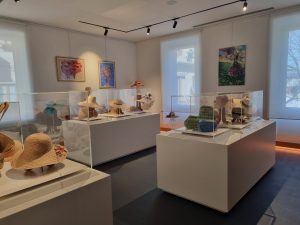
The Museum is easily reachable by train from Florence, it is a ten minute walk from the train station. For information on personalized guided tours of the Signa Straw Museum kindly contact info@myfloraguide.com
A Florentine straw hat for My Flora Guide
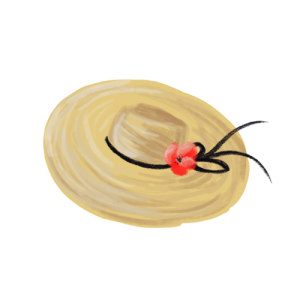 In 2023, I felt the desire to customize the My Flora Guide logo and I contacted Emma Fontana, an elegant and very pretty young girl who was able to translate my imagination into a drawing.
In 2023, I felt the desire to customize the My Flora Guide logo and I contacted Emma Fontana, an elegant and very pretty young girl who was able to translate my imagination into a drawing.
The straw hat with the black ribbon, with a pinned red poppy, represents exactly my idea of Tuscany, my Florentine fairy tale, and my love for gardens, slowness, and – why not? – also my favourite movie, Gone with the Wind!
Lorenzo the Magnificent wisely wrote:
“Cerchi chi vuol le pompe, e gli alti onori
le piazze, e i templi, e gl’edifici magni,
le delizie, il tesor, quali accompagni
mille duri pensier, mille dolori.
Un verde praticel pien di bei fiori,
un rivolo che l’erba intorno bagni,
un augelletto, che d’amor si lagni,
acqueta molto meglio i nostri ardori.”
(Sonetto XXX del Commento)
… With a nice Florentine straw hat on your head… it’s even better.
Waiting for you at the Straw Museum in Signa 😊
USEFUL LINKS:
Straw Museum in Signa: https://www.museopaglia.it/
Consortium “Il Cappello di Firenze”: https://www.ilcappellodifirenze.it/
Emma Fontana @laemmina (Instagram)
